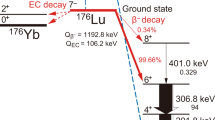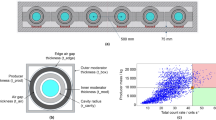Abstract
ON October 25, 1968, we searched for X-rays from M–87 using a balloon-borne detector. The detector consisted of two xenon proportional counter arrays with a combined sensitive area of 2,000 cm2. The electronic systems of the two arrays were identical, and they operated completely independently. A five channel pulse height analyser in each system covered the energy range from 15 keV to 65 keV. Pulse shape discrimination circuits were used successfully to suppress the background radiation1. The collimation for both systems was 13° FWHM. The azimuth of the detector was stabilized by a servo-compensated torque motor, using the Earth's magnetic field as a reference. An on-board control device changed the azimuth and zenith angles according to a programme set before launch. Crossed magnetometers and a Sun sensor measured the azimuth, and a shaft encoder measured the zenith angle. The energy channel settings and stability of the instrument were checked twice each hour during the flight by exposing the detector to a 241Am radioactive source. The counting rate, housekeeping and orientation data were all photographically recorded on board.
This is a preview of subscription content, access via your institution
Access options
Subscribe to this journal
Receive 51 print issues and online access
$199.00 per year
only $3.90 per issue
Buy this article
- Purchase on Springer Link
- Instant access to full article PDF
Prices may be subject to local taxes which are calculated during checkout
Similar content being viewed by others
References
Ricker, G. R., and Gomes, J. J., Rev. Sci. Instrum., 40, 227 (1969).
Overbeck, J. W., and Tananbaum, H. D., Phys. Rev. Lett., 20, 24 (1968).
Clark, G. W., Lewin, W. H. G., and Smith, W. B., Astrophys. J. Lett., 152, L49 (1968).
Stein, J. A., and Lewin, W. H. G., J. Geophys. Res., 72, 383 (1967).
Friedman, H., and Byram, E. T., Science, 158, 257 (1967).
Bradt, H., Mayer, W., Naranan, S., Rappaport, S., and Spada, G., Astrophys. J. Lett., 150, L199 (1967).
Haymes, R. C., Ellis, D. V., Fishman, G. J., Glenn, S. W., and Kurfess, J. D., Astrophys. J. Lett., 151, L125 (1968).
Felten, J. E., Astrophys. J., 151, 861 (1968).
Allen, R. J., Barrett, A. H., and Crowther, P. P., Astrophys. J., 151, 43 (1968).
De Vaucouleurs, G., Angione, R., and Fraser, C. W., Astrophys. Lett., 2, 141 (1968).
Author information
Authors and Affiliations
Rights and permissions
About this article
Cite this article
McCLINTOCK, J., LEWIN, W., SULLIVAN, R. et al. High Energy X-ray Study of M–87. Nature 223, 162–163 (1969). https://doi.org/10.1038/223162b0
Received:
Issue Date:
DOI: https://doi.org/10.1038/223162b0
This article is cited by
-
Preliminary data on the optical variability of the jet emanating from the nucleus of NGC 4486 (M87)
Astrophysics (1974)
-
Energy spectrum and time variations of hard X-rays from Cyg X-1
Astrophysics and Space Science (1972)
-
Variability in the X-ray Flux from M87
Nature Physical Science (1971)
-
Variability of X-ray Emission from M87
Nature (1971)
Comments
By submitting a comment you agree to abide by our Terms and Community Guidelines. If you find something abusive or that does not comply with our terms or guidelines please flag it as inappropriate.



